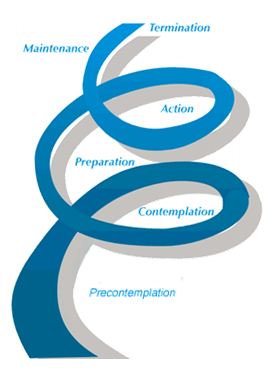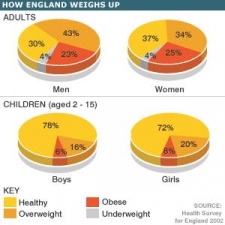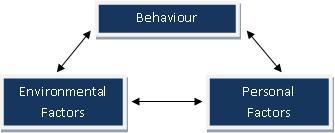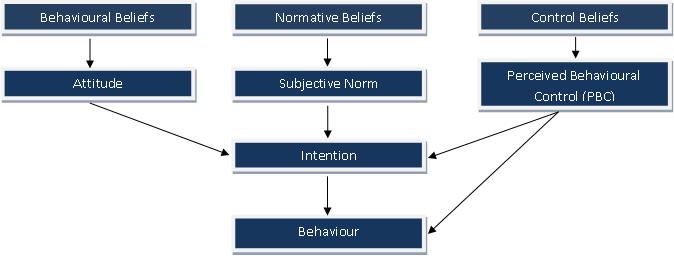Shaping Behaviour and Attitude in Childhood Obesity
Original Editors - Catriona Bartholomew, Brandon Koetsier, Gemma Donohoe, Jessica French and Patrick Holohan
Lead Editors - Your name will be added here if you are a lead editor on this page. Read more.
Introduction [edit | edit source]
Many of the life-long habits that jeopardize health are formed during childhood. Schools provide an excellent opportunity for preventing and treating obesity through changing these habits. Both physical activity and nutrition-focused interventions are already in place in many primary schools. In order to effectively implement these programmes it is important for teachers to understand what brings about the actual change in behaviour.
Designing interventions to produce or change certain behaviours; in this case health behaviours relating to childhood obesity; is best done with an understanding of behaviour change theories and an ability to apply them to practice.
This page will serve as an introduction to influencing attitudes and popular health behaviour models and provide suggestions as how these models may influence your teaching.
Learning Outcomes[edit | edit source]
By the end of this page the reader will be able to:
- Recognize the need to be aware of what brings about behaviour change.
- Describe theories that shape and influence behaviour and attitudes.
- To apply behavioural/attitudinal theories to effectively implement strategies to combat childhood obesity in (primary) school.
- To evaluate the effectiveness of your strategy to change the behaviours of the children.
Theories of Behaviour Change and Attitude [edit | edit source]
Changing Attitude:[edit | edit source]
Negative attitudes of obesity, reported among schoolteachers and children, can promote size discrimination toward large children and body dissatisfaction in children who view their body size as unacceptable. Appropriate education on how to self-monitor daily activity levels can help to empower individuals to maintain healthy long-lasting life-style habits.
To alter an individual’s behaviour it is thought that you must first instill a positive attitude towards the behavior. Weight loss should be looked at from the inside-out, rather than the normal outside-in perspective, meaning, our attitudes and beliefs must be appropriate before methods to change behavior are implemented. One way in which a pre-adolescent can be influenced in their attitudes is to help increase ones self-efficacy and educate them on effects of affirmations.
Shifting a child’s attitude is the first step in varying a child’s negative behaviour and beliefs towards weight. The following are key components that will influence personal attitudes:
Cognitive [feelings]: This component involves the student knowing about the subject that teachers are trying to influence the attitudes on.
Behavorial [thoughts/beliefs]: This component involves having the students engage in the behavior that you want them to display
Affective [action]: This component involves the urge to want to perform the desired behavior.
Affirmations:
[edit | edit source]
Affirmations are statements that declare that something is true. The theory of self-affirmation is a psychological theory with the premise that people are motivated to protect an image of its self-integrity, morality and adequacy. Self-affirmations are said to boost the self-concept and give you confidence to achieve goals. It is vital to keep in mind that attitudes may not directly cause a behavior change but, it is necessary to help alter behavior.
The ‘Create Affirmations’ website has six easy steps to follow when writing self-affirmations:
1. Use the present tense
2. Use your voice, write them how you would speak them
3. Keep affirmations short and precise
4. Make them believable and realistic
5. Be literal
6. Use only positive statements[1].
Self-affirmation has been shown to be effective in terms of promoting a greater acceptance and changes in attitudes, intentions and behaviour[2].
It is important to keep the following in mind when teaching and writing affirmations.
1. Keep information consistent and congruent so individuals can form a single attitude
2. Include messages that are high in affect and emotion (have a shock value)
3. Use messages that connect negative attitudes to past negative behaviours
In understanding how attitudes can be altered with the use of affirmations this strategy can be utilized in daily and weekly activities.
Ways to implement affirmations:[edit | edit source]
• A great site to use to help with writing affirmations is the WIKI How to page, found at : http://www.wikihow.com/Write-an-Effective-Affirmation
• Examples of affirmations: (http://www.vitalaffirmations.com/affirmations.htm#example%20affirmations)
Affirmations for Weight Loss
• I am the perfect weight for me
• I choose to make positive healthy choices for myself
• I will exercise regularly
• I can make healthy choices
• I will be active 3 days a week
Attention, Relevance, Confidence and Satisfaction (ARCS) Model of Motivational Design:[edit | edit source]
Motivation consists of the amount of effort a person is willing to exert in pursuit of a goal; hence, motivation has magnitude and direction [3].
Motivational design is concerned with:
- connecting instruction to the goals of learners
- providing stimulation and appropriate levels of challenge
- influencing how the learners will feel following successful goal accomplishment, or even following failure[4].
Ways to implement model:[edit | edit source]
The following table outlines ways of utilising ARCS Model in a classroom setting.
Changing Behaviour:[edit | edit source]
Presented below are popular health models used to describe how people acquire certain behaviours. There is no 'correct' model, it is best to read through the models and think about which one best suits you and the situation you are trying to apply it to. In addition, suggestions on how the theories can be incorporated into the classroom sessions are provided below each model.
Social Cognitive Theory:[edit | edit source]
The Social Cognitive Theory (SCT) explains how people acquire and maintain certain behaviours [6] and has been extensively used in the field of health behaviour with respect to health promotion, prevention and modification[7].
Human behaviour is explained in terms of a three-way, dynamic, reciprocal model in which personal factors, environmental influences and behaviour constantly interact (Figure 1).
Figure 1: Triadic model from SCT.
An individual’s behaviour is uniquely determined by these interactions. Within this framework there are key constructs which determine behaviour patterns. The core determinants, in terms of health behaviour, are described in Table 2 [8], [7], [9].
| Components |
|
|---|---|
| Knowledge |
of health risks and benefits |
| Reinforcements |
to establish the pattern of behaviour |
| Observational Learning |
Acquisition of behaviour through observation and experience |
| Self-regulation |
individual’s ability to manage or control behaviour |
| Outcome Expectations |
The outcomes people expect their actions to bring about. The perceived importance of these expectations may also drive behaviour. |
| Goal Setting |
establishing both individual and group SMART goals |
| Perceived Self-Efficacy |
An individual’s confidence in their own ability to perform behaviour. |
Self-efficacy is an important determinant of behaviour and is incorporated into many models of behaviour change. Self-efficacy makes a difference to how people think, feel and act [6]; [10]. According to the SCT a personal sense of control makes behavioural change possible [11]. Bandura proposed that the actual performance of a particular behaviour is highly related to an individual’s perceived self-efficacy [12].
Low self-efficacy:
- lower expectations of successfully performing behaviour
- more effected by counterproductive situational temptations
High self-efficacy:
- Expects to succeed at performing behaviour
- More likely to succeed at performing behaviour
Unlike other models of health behaviour the Social Cognitive Theory offers both predictors and principles on how to inform, facilitate, guide and motivate people to adapt habits that promote health and reduce those that impair it [10].
How can this theory shape your teaching?
[edit | edit source]
To increase levels of self-efficacy:
- It may be important to provide resources and support to raise individual confidence.
- Behaviour change should possibly be approached as a series of small achievable steps [13].
- Tasks should be moderately challenging so that students do well and make progress when providing reasonable effort.
Even a strong sense of self-efficacy may not lead to desired behaviour unless there is incentive [14].
- To facilitate behaviour change it may be important to provide incentives and rewards for the behaviours.
- Incentives may increase extrinsic motivation especially where intrinsic motivation is lacking.
Shaping the environment may encourage behaviour change.
- Provide opportunities for behavioural change
- Assist with changes
- Offer social support
- Recognize constraints that may deter behaviour change.
Outcome expectations:
- Students must believe if they complete learning tasks successfully, the outcomes they achieve are worthy of the effort necessary to reach them.
Goal setting:
- Goals that students set or endorse themselves have a bigger impact on their behaviour than goals that are assigned.
- Goals must be SMART (specific, measurable, attainable, realistic and time-targeted).
Theory of Planned Behaviour:[edit | edit source]
The Theory of Planned Behavior (TPB) is an extension of the theory of reasoned action (TRA). It states that the proximal determinant of behavior is the intention to act. The intention, in turn, is influenced by the attitude towards the behavior, the subjective norm, and the perceived behavioral control[15].
[16]
Subjective norm refers to the individual’s perceptions of general social pressure to perform (or not to perform) the behaviour. If an individual perceives that significant others endorse (or disapprove of) the behaviour, they are more (or less) likely to intend to perform it. Attitude towards the behaviour reflects the individual’s global positive or negative evaluations of performing a particular behaviour. In general, the more favourable the attitude towards the behaviour, the stronger should be the individual’s intention to perform it [17].
Perceived behavioral control is defined as an individual’s perceptions of their ability or feelings of self-efficacy to perform behavior. This relationship is typically dependent on the type of relationship and the nature of the situation.
Perceived behavioral control can also predict behaviour directly to the extent that the measure matches actual control.
How can this theory shape your teaching?[edit | edit source]
- Intention has been shown to be the most important variable in predicting behaviour change. Intentions are assumed to capture the motivational factors that influence a behaviour and to indicate how hard people are willing to try or how much effort they would exert to perform the behaviour[18].
- This suggests that it may be important to present information to help shape positive attitudes towards the behavior and stress subjective norms or opinions that support the behaviour.
- For perceived behavioural control to influence behaviour change, much like with self-efficacy, a person must perceive that they have the ability to perform the behaviour. Therefore, perceived control over opportunities, resources, and skills needed is an important part of the change process[19].
Transtheoretical (Stages of Change) Model:
[edit | edit source]
|
In the transtheoretical model, there are six stages that together form a progression for change:[20]Cite error: Invalid
These changes are described as "spiraling or cyclical", rather than a straight forward progression. This is due to the fact that individuals progress through the stages at different rates, and it is very common for individuals to move back and forth along the chain, before eventually reaching the desired goal of maintenance. [23] |

|
Moving forward through the stages are influenced by a set on independent variables known as "processes of change". These processes of change are a major contributing factor that allows us to understand how the shift in behaviour occurs. Numerous studies reveal that in order to have succesful behavioural change, these different processes should be used at particular stages of change[20].
Processes of Change: Experiential = early stage transitions Cite error: Invalid <ref> tag; name cannot be a simple integer. Use a descriptive title
1. Consciousness Raising (Increasing awareness)
ex. I remember some information that people gave me on how to not be obese
2. Dramatic Relief (Emotional arousal)
ex. I react emotionally to warnings about obesity and the dangers it can cause to my health
3. Environmental Reevaluation (Social reappraisal)
ex. I consider the view that obesity can be harmful to myself and others
4. Social Liberation (Environmental Opportunities)
ex. I see how society is changing in ways that make it easier to help with obesity
5. Self Reevaluation (self reappraisal)
ex. Seeing how obese I am makes me feel disappointed in myself.
Processes of Change: Behavioral = later stage transitions Cite error: Invalid <ref> tag; name cannot be a simple integer. Use a descriptive title
6. Stimulus Control (Re-engineering)
ex. I remove things from my home and lifestyle that may contribute to my obesity
7. Helping relationship (supporting)
ex. I have someone who listens when I need to talk about my obesity habits
8. Counter Conditioning (substituting)
ex. I find that doing other things instead of eating and sitting around are good for my obesity
9. Reinforcement Management (rewarding)
ex. I will give myself a reward when I lose some weight
10. Self Liberation (committing)
ex. I make commitments not to be obese anymore.
How can this theory shape your teaching?[edit | edit source]
- It is very important to match behavior change interventions to people's stages. (e.g. If the student is in the precontemplation stage, it is important to provide to them the information about the pro's and con's about losing weight).
- Without a planned intervention, people will remain stuck in the early stages due to lack of motivation to move through the stages
- Using the Transtheoretical model in the classroom:
- When children are in the precontemplation/contemplation stage, various activities have been known to work:
o Learn the child’s current level
o Identify cues to non-engagement in physical activity
o Identify benefits of engaging in physical activity
o Identify choice that can increase the child’s physical activity
o Identify the child’s BMI
o Identify the impact of obesity on the child’s social function
- When children are in the action/completion stage, various activities have been known to work:
o Increase physical activity goals
o Reduce barriers to physical activity
o Recognize benefits of increased physical activity
o Engage in less sedentary activities
o Provide physical activities after school
Intrinsic and extrinsic motivation are both very important to the adoption and maintenance of physical activity. In order to move through the stages, an individual needs to increase their intrinsic and extrinsic motivation. They found that as the stages progressed, the levels of intrinsic and extrinsic motivation increased.
- In the pre-action stage, “tangible rewards” were more highly endorsed.
- Extrinsic motivators, such as tangible results or receiving monetary compensation may be stronger as people consider and adopt an exercise.
- Intrinsic motivators (effort competence and interest-enjoyment) was highest for participants in the maintenance stage. Showing that continued participation in regular activity relies on internal positive factors.
Cognitive approaches are most effective when individuals have not yet changed their behavior.
- Cognitive approaches may include:
o Consciousness raising (increasing knowledge of obesity and the health effects of diet, physical activity, and environment)
o Social liberation: (modifying diet, physical activity, and environmental factors, resulting in social benefits)
o Self evaluation: (examining the effects of current diet, physical activity, and environmental factors on obesity and health
o Environmental reevaluation: (exploring the relationships between diet, physical activity, and environmental factors, and the physical, social, and emotional environments).
Behavioral strategies are more appropriate when individuals have initiated or are attempting to maintain new behaviors.
- These may include:
o Self liberation (telling oneself that it is possible to change diet, physical activity, and environmental factors)
o Counterconditioning: (finding a substitute behavior for the usual diet, physical activity, and environmental factors)
o Stimulus control (removing items or stimuli that remind one of the usual diet, physical activity, and environmental factors)
Bringing Theory to the Classroom: [edit | edit source]
Questionnaire:[edit | edit source]
Develop a questionnaire using the TPB on health and physical activity (PA) behaviors, including assessment of attitude, subjective norm, perceived behavioral control (PBC), and intention to participate in regular PA. Findings from such questionnaires will have implications for tailoring future interventions for obese children.
Previous studies suggest that to achieve greatest PA gains, interventions should implement strategies that reflect the findings on the importance of attitude and especially PBC, for obese children. They also suggest that PA interventions aimed at obese children should endeavor to provide information highlighting the benefits of participating in regular PA [24], for example, making PA enjoyable (see below).
Education on healthy weights:[edit | edit source]
Children are very easily influenced and may take things they see in magazine and on TV to heart without totally understanding the consequences behind what they see. Having a discussion on the pros and cons of certain programs on TV and in magazines may help to educate and allow children to understand what healthy means, it doesnt mean you have to be skinny as a female and buff as a male, its moreso the importance to daily and weekly physical activity and healthy eating (proper portion sizes, eating sweets and biscuits in moderation).
Affirmations:[edit | edit source]
• Write affirmations as a class to be said out loud once a day. These affirmations can change for each day of the week to decrease the risk of students becoming bored with the positive self-statements. Another idea is change the affirmations every two weeks and repeat the same 3-4 affirmations daily. These will help with self-esteem however they will be more effective if each pupil writes personal affirmations. The use of journals in class can help with this.
Quality Daily Physical Activity (QDPA)[edit | edit source]
It is crucial that individuals dont stay sendentary for prolonged periods. Having children get up and get moving once ever class will help children focus on the task at hand as well as reduce the amount of fidgiting and disruptions caused in class. QDPA is a way for children to get up and stretch of move and it can be incorporated into curriculum work. Ideas are:
• Learning a second language? Lets gets up and get moving like our favorite animals, however before we ‘walk like dog’, ‘stretch like a cat’ you first need to say the animal in the second language.
• Simon says in the second language.
• Studying for a math test? Have all students stand up in a straight line (side by side) and ask them math questions, if they get the question right they are allowed to take one step forward, If they are wrong they stay where they are. The first to the other side of the classroom wins a prize (maybe a bonus point on the test!).
• Follow the leader
Intrinsic and extrinsic motivation:[edit | edit source]
Don't focus on negative aspects - positive attitude is more likely to facilitate behaviour change.
• Children need to be intrinsically motivated to implement change. Being told they need to alter attitudes or behaviours decreases the chances of maintaining these changes. If the child is intrinsically motivated, they decide they want to change and motivation comes from their own thoughts, they will be more likely to accept ideas to help alter attitudes and behaviour. It is therefore important to have the children input ideas of how we can accept healthy attitudes and behaviours. Have an idea board and let the class come up with ideas for QDPA or ways to help challenge each other to become more active and healthy.
Improving self-efficacy with the use of models:[edit | edit source]
With higher self-efficacy students are more likely to get involved and gain more from interventions.
Student models during lesson:
- Select students with a variety of skill levels for the demonstration, and confirm that the student can accomplish the skill correctly in the demonstration prior to having them model it in front of the class.
- In order for the models to be effective with the student you are working with, the student must perceive herself to be as skillful or more skillful than the models you are using.
- If your student sees someone succeed whom they believe is less skilled than them, then they will believe that they can also perform the task.
Oral questioning:
These tips may help with ensuring the whole class is involved:
Ask open-ended questions that allow for a variety of responses.
Develop a hand signal system with your class. You might have the students show thumbs up for a “risk-taker” answer that they are unsure about, but would like to share.
Let students know that they do not have to proceed alone. When they are unsure or incorrect, allow them to consult with other students to develop a better answer.
Acknowledge all who contribute to solving a question. Even students who have risked giving an incorrect answer at the start of a lesson have contributed toward the solution.
Students can put their answers on white boards and display the boards toward the teachers. There is something less intimidating about writing an answer that can easily be erased.
Working in small groups:
- Students who already understand concepts can also serve as models by demonstrating the concepts to other students so they can learn with and from each other.
- group work should be structured such that each member of a group can contribute to the process.
Cross-age tutoring:
- Cross-age tutoring is another effective use of modeling as the younger students look up to the older students.
- This also gives older students an opportunity to recognize how much progress they have made, as they compare their knowledge level with younger students.
Involving former students:
- This may let the students know that others like themselves have successfully accomplished what they are about to attempt.
- The more your students see themselves similar to the successful model you provided, the more confident they will be about doing well on the new task.
Useful links
[edit | edit source]
Provided below are some useful links for those requiring more information on any of the content of this page:
A useful visual guide on implementing ARCS Model:
http://www.torreytrust.com/images/ITH_Trust.pdf
Article on role of and applying SCT to the classroom:
http://www.education.com/reference/article/social-cognitive-theory/
Overview of attitude and behaviour change:
http://siteresources.worldbank.org/EXTGOVACC/Resources/BehaviorChangeweb.pdf
A more indepth focus on the Transtheoretical Model
http://www.uri.edu/research/cprc/transtheoretical.htm
Article on role of and applying Transtheoretical Model to the classroom:
http://www.ncbi.nlm.nih.gov/pubmed/18339335
References[edit | edit source]
- ↑ Creative Affirmations. Writing affirmations. http://www.creativeaffirmations.com/writing-affirmations.html (accessed 23 October 2012).
- ↑ Sparks, P., Jessop, D.C., Chapman, J. and Holmes, K. 2010. Pro-environmental actions, climate change, and defensiveness: do self-affirmations make a difference to people's motives and beliefs about making a difference? British Journal of Social Psychology, 49 (3) 09, pp.553-568.
- ↑ Visser, J. and Keller, J.M. 1990. The clinical use of motivational messeges: an inquiry into the validity of the ARCS model of motivational design. Instructional Science, 19(6)pp.467-500.
- ↑ Official site of John Keller’s ARCS Model. What is ARCS model? www.arcsmodel.com/ (accessed 12 Nov 2012).
- ↑ Learning Theories. ARCS Model of Motivational Design (Keller). http://www.learning-theories.com/kellers-arcs-model-of-motivational-design.html (accessed 12 Nov 2012).
- ↑ 6.0 6.1 Bandura, A. 1977. Self-efficacy: toward a unifying theory of behavioural change. Psychological Review, 84 pp. 191-215.
- ↑ 7.0 7.1 Redding, C.A., Rossi, J.S., Rossi, S.R., Velicer, W.F. and Prochaska, J.O. 2000. Health Behaviour Models. The International Electronic Journal of Health Education, 3 pp. 180-193.
- ↑ Bandura, A. 2004. Health Promotion by Cognitive Means. Health Education and Behaviour, 31 (2) pp. 143 – 164.
- ↑ Communication for Governance and Accountability Program. Theories of Behaviour Change. [online] Available from: http://siteresources.worldbank.org/EXTGOVACC/Resources/BehaviorChangeweb.pdf [Accessed October 20 2012].
- ↑ 10.0 10.1 Bandura, A. 1997. Self-Efficacy: The Exercise of Control. New York, Freeman. Worth Publishers, 1st edition.
- ↑ Connor, M. and Norman, P. 2005. Predicting Health Behaviour. 2nd ed. Maidenhead, UK: Open University Press.
- ↑ Redding, C.A., Rossi, J.S., Rossi, S.R., Velicer, W.F. and Prochaska, J.O. 2000. Health Behaviour Models. The International Electronic Journal of Health Education, 3 pp. 180-193.
- ↑ Perry, C. L., Barnowski, T., and Parcel, G. S. 1990. How individuals, environments, and health behavior interact: Social learning theory. In K. Glanz, F. M. Lewis &amp;amp;amp; B. K. Rimer (Eds.), Health Behavior and Health Educaiton: Theory Research and Practice. San Francisco, CA: Jossey-Bass.
- ↑ Bandura, A. 1986. Social Foundations of Thought and Action. Englewood Cliffs, NJ: Prentice-Hall.
- ↑ Armitage, C.J. and Conner, M. 2001. Efficacy of the theory of planned behaviour: A meta‐analytic review. British journal of social psychology, 40 (4)pp.471-499.
- ↑ Ajzen, I. The Theory of Planned Behavior. Organizational Behavior and Human Decision Processes 1991;50:179–211
- ↑ Hardeman, W., Johnston, M., Johnston, D., Bonetti, D., Wareham, N. &amp;amp;amp;amp;amp;amp;amp;amp;amp;amp;amp;amp;amp;amp; Kinmonth, A.L. Application of the theory of planned behaviour in behaviour change interventions: a systematic review. Psychology and health. 2001;17:2:123-158.
- ↑ Communication for Governance and Accountability Program. Theories of Behaviour Change. [online] Available from: http://siteresources.worldbank.org/EXTGOVACC/Resources/BehaviorChangeweb.pdf [Accessed October 20 2012].
- ↑ Communication for Governance and Accountability Program. Theories of Behaviour Change. [online] Available from: http://siteresources.worldbank.org/EXTGOVACC/Resources/BehaviorChangeweb.pdf [Accessed October 20 2012].
- ↑ 20.0 20.1 Velicer, W. F, Prochaska, J. O., Fava, J. L.,Norman, G. J., and Redding, C. A. 1998.Smoking cessation and stress management:Applications of the Transtheoretical Model of behavior change. Homeostasis, 38, pp. 216-233 retrieved from: http://www.uri.edu/research/cprc/TTM/detailedoverview.htm
- ↑ Lach, H. Everard, K. Highstein, G. Brownson, C. 2004. Application of the Transtheoretical Model to Health Education for Older Adults. Health Promotion Practice. 5 (1) pp. 88-93
- ↑ Bibeau, W., Moore, J., Caudill, P. and Topp, R. 2008. Case Study of a Transtheoretical Case Management Approach to Addressing Childhood Obesity. Elsevier inc. 23 (2) pp. 92-100
- ↑ Sharma, M. and Romas, A. J. 2012. Theoretical foundations of health education and health promotion. Jones and Bartlett Learning. Sudbury, MA.
- ↑ Boudreau, F., &amp;amp;amp; Godin, G. Theory of planned behavior to predict exercise intention in obese adults. Canadian Journal of Nursing Research. 2007; 3:112-125.
</fck:hr>










